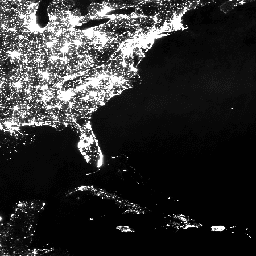Page Summary
-
This dataset provides an annual time series of global VIIRS nighttime lights from 2012 to 2024.
-
The data is produced from monthly cloud-free average radiance grids and undergoes filtering to remove outliers and background noise.
-
The dataset includes bands such as average, maximum, and median DNB radiance values, along with cloud-free coverage information.
-
This public domain data is provided by the Earth Observation Group at the Colorado School of Mines with no restrictions on use or distribution.
-
The data can be accessed and explored through the Google Earth Engine platform for research, education, and non-profit use.

- Dataset Availability
- 2012-04-01T00:00:00Z–2024-01-01T00:00:00Z
- Dataset Provider
- Earth Observation Group, Payne Institute for Public Policy, Colorado School of Mines
- Cadence
- 1 Year
- Tags
Description
Annual global VIIRS nighttime lights dataset is a time series produced from monthly cloud-free average radiance grids for 2022. Data for earlier years are available in the NOAA/VIIRS/DNB/ANNUAL_V21 dataset.
An initial filtering step removed sunlit, moonlit and cloudy pixels, leading to rough composites that contains lights, fires, aurora and background. The rough annual composites are made on monthly increments and then combined to form rough annual composites.
The subsequent steps uses the twelve-month median radiance to discard high and low radiance outliers, filtering out most fires and isolating the background. Background areas are zeroed out using the data range (DR) calculated from 3x3 grid cells. The DR threshold for background is indexed to cloud-cover levels, with higher DR thresholds in areas having low numbers of cloud-free coverages.
Bands
Pixel Size
463.83 meters
Bands
| Name | Units | Pixel Size | Description |
|---|---|---|---|
average |
nanoWatts/sr/cm^2 | meters | Average DNB radiance values. |
average_masked |
nanoWatts/sr/cm^2 | meters | Average Masked DNB radiance values |
cf_cvg |
meters | Cloud-free coverages; the total number of observations that went into each pixel. This band can be used to identify areas with low numbers of observations where the quality is reduced. |
|
cvg |
meters | Total number of observations free of sunlight and moonlight. |
|
maximum |
nanoWatts/sr/cm^2 | meters | Maximum DNB radiance values. |
median |
nanoWatts/sr/cm^2 | meters | Median DNB radiance values |
median_masked |
nanoWatts/sr/cm^2 | meters | Median masked DNB radiance values. |
minimum |
nanoWatts/sr/cm^2 | meters | Minimum DNB radiance values |
Terms of Use
Terms of Use
Colorado School of Mines data, information, and products, regardless of the method of delivery, are not subject to copyright and carry no restrictions on their subsequent use by the public. Once obtained, they may be put to any lawful use. The forgoing data is in the public domain and is being provided without restriction on use and distribution.
Citations
Elvidge, C.D, Zhizhin, M., Ghosh T., Hsu FC, Taneja J. Annual time series of global VIIRS nighttime lights derived from monthly averages:2012 to 2019. Remote Sensing 2021, 13(5), p.922, doi:10.3390/rs13050922 doi:10.3390/rs13050922
DOIs
Explore with Earth Engine
Code Editor (JavaScript)
var dataset = ee.ImageCollection('NOAA/VIIRS/DNB/ANNUAL_V22') .filter(ee.Filter.date('2022-01-01', '2023-01-01')); var nighttime = dataset.select('maximum'); var nighttimeVis = {min: 0.0, max: 60.0}; Map.setCenter(-77.1056, 38.8904, 8); Map.addLayer(nighttime, nighttimeVis, 'Nighttime');